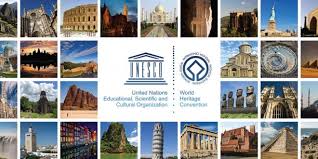42nd session of World Heritage Committee: Four sites added to UNESCO’s World Heritage List
The 42nd session of World Heritage Committee (WHC) meeting of United Nations Educational, Scientific and Cultural Organization (UNESCO) held in Manama, Bahrain has inscribed four cultural sites on the World Heritage List. These four cultural sites are Victorian Gothic and Art Deco Ensemble of Mumbai (India), Sassanid Archaeological Landscape of Fars region (Iran), Hidden Christian Sites in Nagasaki Region (Japan) and Sansa, Buddhist Mountain Monasteries in Korea (South Korea).
Key Facts
Victorian Gothic and Art Deco Ensemble of Mumbai: These two ensembles bear testimony to the phases of modernization that Mumbai has undergone in course of the 19th and 20th centuries. Mumbai’s Victorian ensemble includes Indian elements suited to climate, including balconies and verandas. Art Deco edifices are found in cinemas and residential buildings, having blend of Indian design with Art Deco imagery, creating unique style that has been described as Indo-Deco.
Sassanid Archaeological Landscape of Fars region: They are eight archaeological sites situated in three geographical parts in southeast of Fars Province of Iran viz. Firuzabad, Bishapur and Sarvestan. These fortified structures, palaces, and city plans date back to earliest and latest times of Sassanian Empire (from 224 to 658 CE). These sites bear witness to influence of Achaemenid and Parthian cultural traditions and of Roman art, which had significant impact on architecture and artistic styles of the Islamic era.
Hidden Christian Sites in Nagasaki Region: It is located in north-western part of Kyushu Island. The 12 components of the site consist of 10 villages, Hara Castle and cathedral, built between the 16th and 19th centuries. Together they reflect earliest activities of Christian missionaries and settlers in Japan. These sites also bear unique testimony to cultural tradition nurtured by hidden Christians in Nagasaki region who secretly transmitted their faith during period of prohibition from 17th to 19th century.
Sansa, Buddhist Mountain Monasteries in Korea: They are Buddhist mountain monasteries located throughout southern provinces of Korean Peninsula. They are spatial arrangement of seven temples that comprise site, (established from 7th to 9th centuries), present common characteristics that are specific to Korea– “madang” (open courtyard) flanked by four buildings (pavilion, Buddha Hall, lecture hall and dormitory). They contain large number of individually remarkable structures, objects, documents and shrines. These mountain monasteries are sacred places, and have survived as living centres of faith and daily religious practice.
UNESCO World Heritage Sites
The World Heritage Sites are sites selected by UNESCO, having cultural, historical, scientific or other form of significance and is legally protected by international treaties The list is maintained by international World Heritage Programme administered by the UNESCO World Heritage Committee. The committee comprises of 21 UNESCO member states which are elected by UN General Assembly.
Each World Heritage Site included in the list remains part of the legal territory of the state where it is located. But inclusion of sites in the list by UNESCO is in interest of the international community to preserve each site. Presently, Italy with 50 sites is home to the greatest number of World Heritage Sites.
Month: Current Affairs - July, 2018


